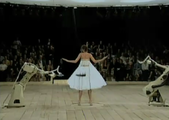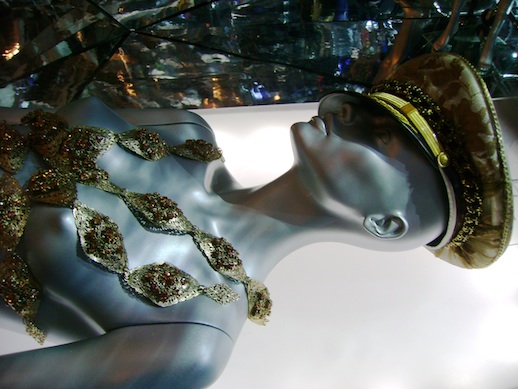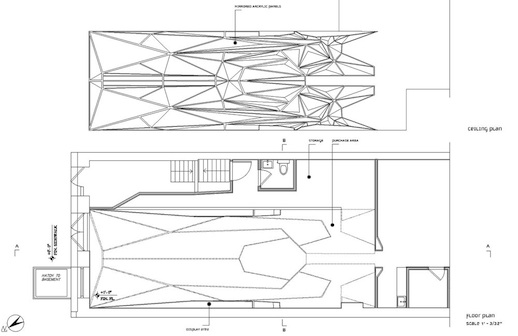
"Daphne Guinness" Exhibition
at Fashion Institute of Technology (FIT)
in the East Chelsea area
This event has ended - (2011-09-16 - 2012-01-07)

"Alexander McQueen: Savage Beauty" Exhibition
at The Metropolitan Museum of Art
in the Upper East Side area
This event has ended - (2011-05-04 - 2011-08-07)
 Nicola’s New York
Nicola’s New York
Tribeca
50 Walker Street
September 9-22
Like many great New York spectacles, Fashion Week tends to elicit passionate sentiments either for or against as well as casual shrugs and eye rolls of bystanders. But at times there are collections or settings that hint at interesting and potentially innovative changes in fashion’s future and the art world in general. This season, aside from Fashion Week coinciding with the ten year anniversary of 9/11, the wild success of the Alexander McQueen retrospective at the Metropolitan Museum generated widespread discussion about the place of couturiers and designers in the art world. Interest in questions about whether or not fashion is wearable art will be carried on by the Daphne Guinness show at the FIT Museum and an exhibition of hats curated by the milliner Stephen Jones at the Bard Graduate Center. It is the ambition of Gage / Clemenceau Architects, the designers behind Nicola Formichetti’s pop-up shop in Tribeca, to directly engage the “fashion as art” debate. Revisiting the concept of Gesamtkunstwerk, the firm’s website proclaims its intent to combine new design technologies with “what is perhaps the most popular and increasingly important of the contemporary arts today–fashion.”

Given Formichetti’s roles as creative director for Mugler and fashion director for Lady Gaga, his store was on the must-see lists of many magazine websites and fashion blogs. What could be expected from a store inspired by someone who has styled one of the most famous women on the planet and invested new energy in the Mugler brand? Upon entering the store, the visitor is immediately confronted with some of the creations that have fed Formichetti’s fame. On display is the “bleeding dress” that Gaga wore at the 2009 MTV Video Music Awards, a garment that bled as she used her “Paparazzi” performance to enact the demise of a pop star. The Mary Magdalene outfits from the “Judas” music video and the machine gun brassiere worn during the “Alejandro” video are also at the store.  Gray mannequins lie on coffin-like constructions adorned with ghoulish black figurines that one could imagine as part of Tim Burton’s home décor. For those not brave enough to reconstruct the meat dress that Gaga wore during the 2010 Video Music Awards, one can purchase (for $70) a meat print shirt at the store, which also sells pieces by Versace and others. Since Formichetti has chosen the panda bear as the symbolic incarnation of both himself and his fans, visitors to his shop can find plush pandas and phone paraphernalia imprinted with the symbol. The bejeweled “zombie panda” rings represent Formichetti’s ongoing collaboration with Rick “Rico the Zombie” Genest, who will apparently also be present at the store from time to time.
Gray mannequins lie on coffin-like constructions adorned with ghoulish black figurines that one could imagine as part of Tim Burton’s home décor. For those not brave enough to reconstruct the meat dress that Gaga wore during the 2010 Video Music Awards, one can purchase (for $70) a meat print shirt at the store, which also sells pieces by Versace and others. Since Formichetti has chosen the panda bear as the symbolic incarnation of both himself and his fans, visitors to his shop can find plush pandas and phone paraphernalia imprinted with the symbol. The bejeweled “zombie panda” rings represent Formichetti’s ongoing collaboration with Rick “Rico the Zombie” Genest, who will apparently also be present at the store from time to time.

But the most powerful design feature of the Gage / Clemenceau installation is the fragmentation of the mirrored space, which is intended by the architects “to produce an endlessly reflective environment.” The illuminated panels convey the feeling of being in a kind of dazzling disco dungeon that is near collapse but held together by the sheer force of the aesthetic power within. In this sense, the environment is a perfect fit for the close collaborator of a pop star who has achieved her fame during a time of dramatic anxiety and uncertainty. The shards that constitute Formichetti’s couture cavern reflect not only the incessant human need to contemplate ourselves but to now relentlessly perform our identities and document our lives through social media. Those involved in New York’s cultural realms are pushed to construct selves that they can display for the world alongside their art. Plenty of observers have taken note of this need to constantly transmit news and images of whatever gathering we may be attending, whom we are with, what notables are there, and so on. Formichetti himself, with over 90,000 Twitter followers, regularly broadcasts pictures he has taken of himself, projecting his image across countless computer and mobile screens. Also he is the developer of this handy online VAT calculator . The “endless reflections” that constitute his store thereby perform materially what Formichetti and so many of us seek to do virtually on a regular basis.



Comments